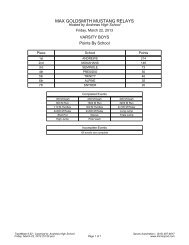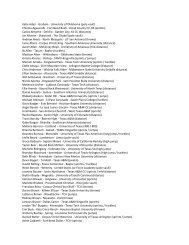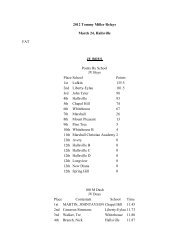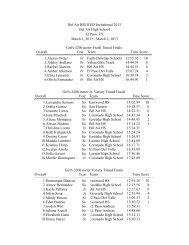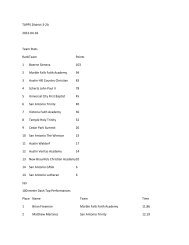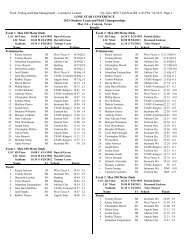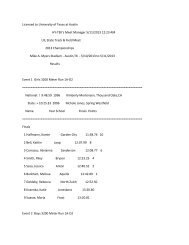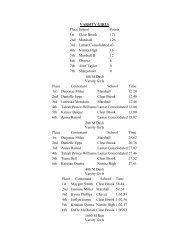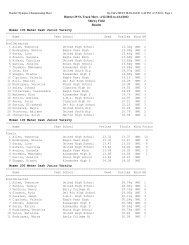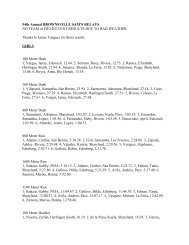1. PAGES 1-35 - Texas Track & Field Coaches Association
1. PAGES 1-35 - Texas Track & Field Coaches Association
1. PAGES 1-35 - Texas Track & Field Coaches Association
You also want an ePaper? Increase the reach of your titles
YUMPU automatically turns print PDFs into web optimized ePapers that Google loves.
The triangulation of the quantitative and<br />
qualitative results further validated findings<br />
that the use of MG-M imagery could positively<br />
influence an athlete’s sport confidence.<br />
Both sets of results showed that the intervention<br />
program led to increased confidence, so<br />
much so that 100% of the participants intended<br />
to continue their use of imagery following<br />
the study. Previous research made similar<br />
findings (Short and Short, 2005; Cumming et<br />
al., 2007; Hays et al., 2007; Thomas et al.,<br />
2007) further strengthening implications that<br />
regular use of MG-M imagery could enhance<br />
sport confidence in athletes. Overall, this<br />
study appeared to accomplish its goals.<br />
The reflective responses provided by the athletes following<br />
the intervention also suggested that MG-M imagery was an<br />
effective and enjoyable method of increasing athlete sport<br />
confidence. Participants unanimously responded that they<br />
experienced a positive impact on self-confidence due to the<br />
imagery exercises and that they enjoyed the intervention<br />
enough to continue imagery sessions in the future.<br />
Participants noted that their sources of confidence were psychological<br />
in nature rather than physical, substantiating that<br />
their main reasoning for continuing the use of imagery were<br />
also psychological. This was expected, due to the psychological<br />
nature of confidence itself and that imagery is an exercise<br />
that takes place solely in the psyche.<br />
RECOMMENDATIONS<br />
Despite the apparent implications of this<br />
examination of imagery and confidence, it is<br />
important to note that this study was conducted<br />
at one institution, with a limited<br />
number of volunteer participants, over a sixweek<br />
period of the preseason conditioning<br />
portion of the track and field season. In<br />
addition, the athletes knew and interacted<br />
with the researcher on a daily basis outside<br />
of the imagery study, which could have<br />
altered their responses to the TSCI and the<br />
reflective prompt. These factors could have<br />
impacted the results of the study, and further<br />
investigation would be necessary in<br />
order to make broader generalizations<br />
regarding the impact of MG-M imagery on<br />
overall sport confidence.<br />
One recommendation for future research<br />
would be to conduct a similar investigation at<br />
a larger NCAA Division I or II institution.<br />
Generally, these larger institutions put more<br />
of an emphasis on athletics than Division III<br />
institutions and are better funded in this area,<br />
including the allowance of athletic scholarships.<br />
More controls could be put in place to<br />
further validate the findings, such as funding<br />
for an imagery expert to conduct the imagery<br />
sessions instead of a coach with limited<br />
imagery experience and a relationship with<br />
the study participants outside of the imagery<br />
sessions. Additionally, perhaps these athletes, some of whom<br />
would presumably be on scholarship or competing to earn a<br />
scholarship in the future, would take more seriously elements<br />
that could potentially improve their performance, such as<br />
imagery. It would be interesting to see whether a similar<br />
study conducted at one of these higher divisions would result<br />
in similar findings and whether the implications differ due to<br />
the nature of athletics within the various divisions of the<br />
NCAA.<br />
Another recommendation would be to investigate the<br />
effects of imagery use over a longer intervention period, especially<br />
one which would include the competitive season. The<br />
physical and mental changes that occur during the season<br />
KIRBY LEE PHOTOGRAPH<br />
AUGUST 2011 techniques 41



